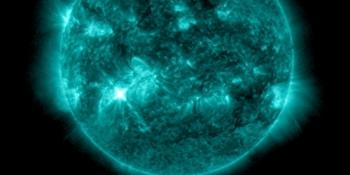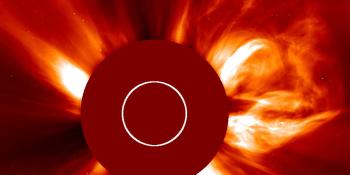Przeglądasz Archiwum z piątek, 27 stycznia 2012
Raport aktywności słonecznej
Każdy wspomniany rozbłysk słoneczny w tym raporcie ma współczynnik skalowania dodany przez Space Weather Prediction Center (SWPC). Przez skale współczynników SWPC, raporty o rozbłyskach słonecznych są o 42% mniejsze niż naukowo jakościowa data. Skale współczynników zostały usunięte z naszych archiwów o rozbłyskach słonecznych by odzwierciedlić prawdziwe jednostki fizyczne.
Raport aktywności słoneczno- geomagnetycznej 2012 Jan 27 2200 UTCPrzygotowane przez NOAA © SWPC i przetworzone przez SpaceWeatherLive.com
Połączenie raportów USAF/NOAA o słonecznej i geofizycznej aktywności
Numer SDF 027 wydany w 2200Z na 27 Jan 2012IA. Analiza aktywności regionów słonecznych i aktywność od 26-2100Z do 27-2100Z Solar activity was high. Region 1402 (N29W88) produced
an X1/1f flare at 27/1837Z with associated Type II (est. speed 1523
km/s) and Type IV Radio Sweeps, along with an 810 pfu Tenflare. An
associated CME was first visible in SOHO/LASCO C2 imagery at
27/1827Z. The majority of the ejecta is directed towards the STEREO
A spacecraft, however, further analysis is necessary to determine
potential geoeffectiveness.
IB. Prognoza aktywności słonecznej
Solar activity is expected to be low
on day one (28 January) with a chance for isolated M-class activity
as Region 1402 rotates around the west limb. Activity is expected to
be very low to low on days two and three (29-30 January).
IIA. Podsumowanie aktywności geofizycznej 26-2100Z do 27-2100Z
The geomagnetic field was quiet to unsettled with isolated active
periods observed at mid-latitudes and an isolated minor storm period
observed at high latitudes. The increase in activity is due to the
arrival of a recurrent coronal hole high speed stream (CH HSS). The
greater than 10 MeV and greater than 100 MeV proton flux at
geosynchronous orbit were above event threshold during the period
due to the X1 flare mentioned above. The greater than 10 MeV proton
event, which began at 27/1905Z and reached 96 pfu at the time of
this writing, is still in progress. The greater than 100 MeV proton
event, which began at 27/1900Z and reached 11 pfu at the time of
this writing, is also still in progress. The Penticton 10.7 cm flux
value was enhanced due to the X1 flare mentioned above. The greater
than 2 MeV electron flux at geosynchronous orbit reached high levels
during the period.
IIB. Prognoza aktywności geofizycznej
The geomagnetic field is
expected to be quiet to unsettled on day one (28 January) due to
continued effects from the CH HSS. Mostly quiet conditions are
expected for days two and three (29-30 January). The greater than 10
MeV and 100 MeV proton events are expected to continue on day one. A
more reliable end time will be possible once the peak levels are
observed.
III. Prawdopodobieństwa zdarzenia 28 Jan do 30 Jan
| Klasa M | 25% | 01% | 01% |
| Klasa X | 05% | 01% | 01% |
| Proton | 99% | 50% | 01% |
| PCAF | Red | ||
IV. Przepływ 10,7 cm z Penticton
Zaobserwowano 27 Jan 142 Przewidywane 28 Jan-30 Jan 120/120/120 Średnia z 90 dni 27 Jan 144
V. Indeks geomagnetyczny A
Zaobserwowano Afr/Ap 26 Jan 005/006 Szacowane Afr/Ap 27 Jan 007/008 Przewidywane Afr/Ap 28 Jan-30 Jan 007/008-005/005-005/005
VI. Prawdopodobieństwa aktywności geomagnetycznej 28 Jan do 30 Jan
| A. Średnie szerokości geograficzne | |||
|---|---|---|---|
| Aktywne | 20% | 10% | 10% |
| Słaba burza | 10% | 01% | 01% |
| Bardzo znacząca burza | 01% | 01% | 01% |
| B. Wysokie szerokości geograficzne | |||
|---|---|---|---|
| Aktywne | 25% | 15% | 15% |
| Słaba burza | 15% | 01% | 01% |
| Bardzo znacząca burza | 05% | 01% | 01% |
Wszystkie czasy w UTC
<< Idź do codziennego przeglądu
Najnowsze wiadomości
Najnowsze wiadomości z forum
2024/12/23 AR13932 M8.9 & M4.1 associated CMEs 16Season greetings from SpaceWeatherLive 3Ask your obscure/"stupid" space weather questions. 129A little bit about our hobby for the general public 10AR 13932 84
Więcej tematówWesprzyj SpaceWeatherLive.com!
Wielu ludzi odwiedza SpaceWeatherLive aby śledzić aktywność słoneczną lub sprawdzić czy jest szansa na zaobserwowanie zorzy polarnej. Niestety, większy ruch na stronie oznacza większe koszty utrzymania serwera. Dlatego, jeśli jesteś zadowolony ze strony SpaceWeatherLive, zachęcamy do wspierania nas finansowo. Dzięki temu będziemy mogli utrzymać naszą stronę.

Fakty na temat pogody kosmicznej
| Ostatnie rozbłyski klasy X | 2024/12/08 | X2.2 |
| Ostatnie rozbłyski klasy M | 2024/12/25 | M4.9 |
| Ostatnia burza geomagnetyczna | 2024/12/17 | Kp5+ (G1) |
| Dni bez plam słonecznych | |
|---|---|
| Ostatni dzień bez skazy | 2022/06/08 |
| Średnia miesięczna liczba plam słonecznych | |
|---|---|
| listopada 2024 | 152.5 -13.9 |
| grudnia 2024 | 115.2 -37.3 |
| Ostatnie 30 dni | 120.1 -38.2 |


